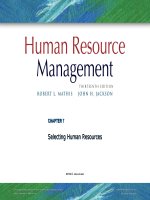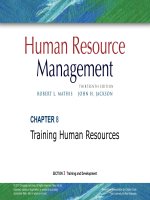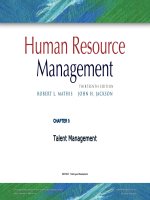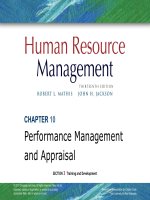Human resrouce management 13th mathis jacson chapter 05
Bạn đang xem bản rút gọn của tài liệu. Xem và tải ngay bản đầy đủ của tài liệu tại đây (1.38 MB, 36 trang )
CHAPTER 5
Human Resource Planning and Retention
SECTION 2 Jobs and Labor
©
© 2011
2011 Cengage
Cengage Learning.
Learning. All
All rights
rights reserved.
reserved. May
May not
not be
be scanned,
scanned, copied
copied or
or duplicated,
duplicated, or
or posted
posted to
to aa
publicly
publicly accessible
accessible Web
Web site,
site, in
in whole
whole or
or in
in part.
part.
PowerPoint
PowerPoint Presentation
Presentation by
by Charlie
Charlie Cook
Cook
The
The University
University of
of West
West Alabama
Alabama
Chapter Objectives
After you have read this chapter, you should be able to:
•
Define HR planning and outline the HR planning process.
•
Describe the means for assessing the external and
internal workforce in HR planning.
•
Identify methods for forecasting HR supply and
demand levels.
•
Explain the nature of the psychological contract and how motivation is linked to individual performance.
•
Describe different kinds of turnover and how turnover can be measured.
•
Identify the six drivers of retention and ways retention measurement can occur.
© 2011 Cengage Learning. All rights reserved. May not be scanned, copied or duplicated, or posted to a publicly accessible Web
site, in whole or in part.
5–2
Human Resource Planning
• Human Resource (HR) Planning
The process of analyzing and identifying the need for and availability of human resources so
that the organization can meet its objectives.
• HR Planning Responsibilities
Top HR executive and subordinates gather information from other managers to use in the
development of HR projections for top management to use in strategic planning and setting
organizational goals.
© 2011 Cengage Learning. All rights reserved. May not be scanned, copied or duplicated, or posted to a publicly accessible Web
site, in whole or in part.
5–3
Purpose of HR Planning
Effective HR Planning
Right
Right
Right
Right
people
capabilities
times
places
© 2011 Cengage Learning. All rights reserved. May not be scanned, copied or duplicated, or posted to a publicly accessible Web
site, in whole or in part.
5–4
HR Forecasting
Strategic HR Planning
Forecast HR requirements (demand)
Yes
Forecast HR availability (supply)
Match?
No
Develop programs to increase supply
Develop programs to decrease supply
or reduce demand
or increase demand
© 2011 Cengage Learning. All rights reserved. May not be scanned, copied or duplicated, or posted to a publicly accessible Web
site, in whole or in part.
5–5
Small Businesses and HR Planning
Attracting and retaining qualified
Management succession between
outsiders
generations of owners
HR Planning Issues in
Small Businesses
Evolution of HR activities as the
business grows
Family relationships and HR policies
© 2011 Cengage Learning. All rights reserved. May not be scanned, copied or duplicated, or posted to a publicly accessible Web
site, in whole or in part.
5–6
FIGURE 5–1
HR Planning Process
© 2011 Cengage Learning. All rights reserved. May not be scanned, copied or duplicated, or posted to a publicly accessible Web
site, in whole or in part.
5–7
Assessing the External Workforce
External Workforce
Economic and
Governmental Factors
Changing Workforce
Competitive Evaluations
Considerations
© 2011 Cengage Learning. All rights reserved. May not be scanned, copied or duplicated, or posted to a publicly accessible Web
site, in whole or in part.
5–8
Assessing the Internal Workforce
• Jobs and Skills Audit
What jobs exist now and how essential is each job?
How many individuals are performing each job?
What are the reporting relationships of jobs?
What are the vital KSAs needed in the jobs?
What jobs will be needed to implement future organizational strategies?
What are the characteristics of those anticipated jobs?
© 2011 Cengage Learning. All rights reserved. May not be scanned, copied or duplicated, or posted to a publicly accessible Web
site, in whole or in part.
5–9
Assessing the Internal Workforce (cont’d)
• Organizational Capabilities Inventory
HR databanks—sources of information about employees’ knowledge, skills, and abilities
(KSAs)
Components of an organizational capabilities inventory:
Individual employee demographics
Individual career progression
Individual performance data
© 2011 Cengage Learning. All rights reserved. May not be scanned, copied or duplicated, or posted to a publicly accessible Web
site, in whole or in part.
5–10
FIGURE 5–2
HR Forecasting Example Methods
© 2011 Cengage Learning. All rights reserved. May not be scanned, copied or duplicated, or posted to a publicly accessible Web
site, in whole or in part.
5–11
FIGURE 5–2
HR Forecasting Example Methods (cont’d)
© 2011 Cengage Learning. All rights reserved. May not be scanned, copied or duplicated, or posted to a publicly accessible Web
site, in whole or in part.
5–12
Forecasting HR Supply and Demand
• Forecasting
Using information from the past and the present to identify expected future conditions.
• Types of Forecasts
HR Demand
Internal Supply
External Supply
• Forecasting Periods
Short-term—less than one year
Intermediate—up to five years
Long-range—more than five years
© 2011 Cengage Learning. All rights reserved. May not be scanned, copied or duplicated, or posted to a publicly accessible Web
site, in whole or in part.
5–13
HR Forecasting Methods
Judgmental
Mathematical
Estimates
Statistical regression analysis
Rules of thumb
Simulation models
Delphi Technique
Productivity ratios
Nominal Groups
Staffing ratios
© 2011 Cengage Learning. All rights reserved. May not be scanned, copied or duplicated, or posted to a publicly accessible Web
site, in whole or in part.
5–14
Forecasting Demand for Human Resources
• Organization-Wide Estimate for Total HR Demand
Unit breakdown for specific skill needs by number and type of employee
Develop decision rules (“fill rates”) for positions to be filled internally and externally.
Develop additional decision rules for positions impacted by the chain effects of internal
promotions and transfers.
© 2011 Cengage Learning. All rights reserved. May not be scanned, copied or duplicated, or posted to a publicly accessible Web
site, in whole or in part.
5–15
Forecasting Supply of Human Resources
• Forecasting External HR Supply
Factors affecting external supply:
Net migration into and out of an area
Individuals entering and leaving the workforce
Individuals graduating from schools and colleges
Changing workforce composition and patterns
Economic forecasts
Technological developments and shifts
Actions of competing employers
Government regulations and pressures
Other circumstances affecting the workforce
© 2011 Cengage Learning. All rights reserved. May not be scanned, copied or duplicated, or posted to a publicly accessible Web
site, in whole or in part.
5–16
FIGURE 5–3
Estimating Internal Labor Supply for a Given Unit
© 2011 Cengage Learning. All rights reserved. May not be scanned, copied or duplicated, or posted to a publicly accessible Web
site, in whole or in part.
5–17
Individual/Organizational Relationships
• The Psychological Contract
The unwritten expectations employees and employers have about the nature of their work
relationships.
Affected by age of employee and changes in economic conditions.
Focuses on expectations about “fairness” that may not be defined clearly by employees.
• Psychological Ownership
When individuals feel that they have some control and perceived rights in the organization,
they are more likely to be committed to the organization.
© 2011 Cengage Learning. All rights reserved. May not be scanned, copied or duplicated, or posted to a publicly accessible Web
site, in whole or in part.
5–18
Components of the Psychological Contract
Employers provide:
•
•
•
Competitive compensation and benefits
Employees contribute:
•
productivity
Flexibility to balance work and home life
Career development opportunities
Continuous skill improvement and increased
•
•
Reasonable time with the organization
Extra efforts and results when needed
© 2011 Cengage Learning. All rights reserved. May not be scanned, copied or duplicated, or posted to a publicly accessible Web
site, in whole or in part.
5–19
Individual Employee Performance and Motivation
•
Individual Performance Factors
1.
Individual’s ability to do the work
2.
Effort expended
3.
Organizational support
Performance (P) = Ability (A) x Effort (E) x Support (S)
© 2011 Cengage Learning. All rights reserved. May not be scanned, copied or duplicated, or posted to a publicly accessible Web
site, in whole or in part.
5–20
FIGURE 5–4
Components of Individual Performance
© 2011 Cengage Learning. All rights reserved. May not be scanned, copied or duplicated, or posted to a publicly accessible Web
site, in whole or in part.
5–21
Individual Motivation
• Motivation
The desire within a person causing that person to act to reach a goal.
• Management Implications for Motivating Individual Performance
Broad-based strategies and tactics to address individual employee concerns about:
Consistency in organizational rewards
Organizational support for employee efforts
Accurate measurement of employee performance
Desirability of rewards by employees
© 2011 Cengage Learning. All rights reserved. May not be scanned, copied or duplicated, or posted to a publicly accessible Web
site, in whole or in part.
5–22
Nature of Job Satisfaction
• Job Satisfaction
A positive emotional state resulting from evaluating one’s job experience.
• Organization Commitment (Loyalty)
The degree to which employees believe in and accept organizational goals and desire to
remain with the organization.
Employee engagement: the extent to which an employee feels linked to organizational
success.
Continuance commitment: the likelihood that an individual will stay with rather than withdraw
from the organization.
© 2011 Cengage Learning. All rights reserved. May not be scanned, copied or duplicated, or posted to a publicly accessible Web
site, in whole or in part.
5–23
FIGURE 5–5
Factors Affecting Job Satisfaction and Organizational
Commitment
© 2011 Cengage Learning. All rights reserved. May not be scanned, copied or duplicated, or posted to a publicly accessible Web
site, in whole or in part.
5–24
Employee Turnover
• Turnover
The process in which employees leave an organization and have to be replaced.
• Impact of Turnover
Inability to achieve business goals
Loss of “image” to attract other individuals
High costs of turnover and replacement
Churn—hiring new workers while laying off others
© 2011 Cengage Learning. All rights reserved. May not be scanned, copied or duplicated, or posted to a publicly accessible Web
site, in whole or in part.
5–25









